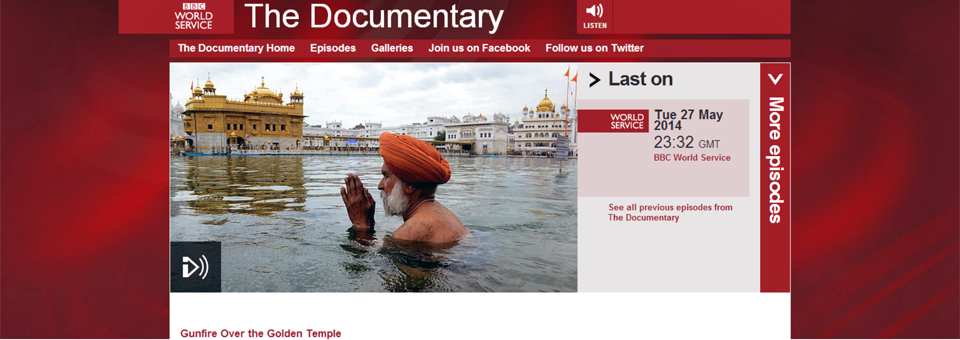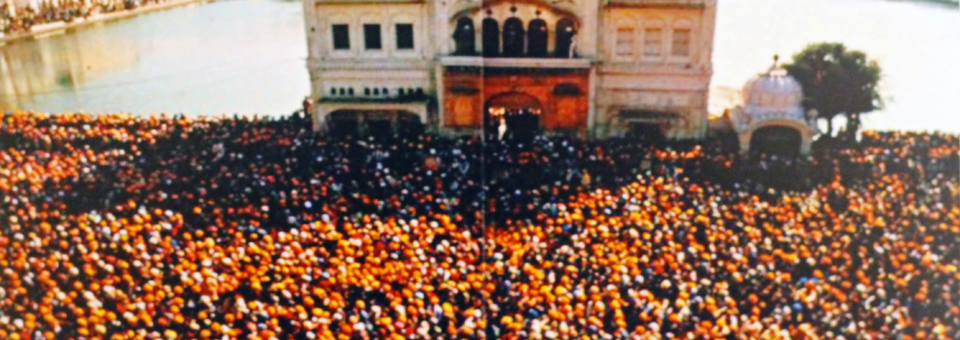Mark Tully’s recent radio program for the BBC world service had the rapt attention of the Sikh community (in addition to its estimated 150 million+ global listeners). ‘Gunfire Over the Golden Temple’ was billed as a radio documentary to bring the events of June 1984 and the 30 years that followed “right up to date”.
Our community often widely promotes such programmes, perhaps out of a sense of seeking validation from those whom we perceive to be in power. It’s as if our conversation, our history, the very lives of our people are more valuable, more interesting and more acceptable if they are discussed in circles outside of our own local and national sangats. There is always this feeling, lingering at the back of the mind that maybe, just maybe this will be the one programme to tell the truth.
As a journalist Mark Tully has a responsibility to his profession and his audience to be thorough and objective in presenting both sides of the argument, so that the listener may make a decision and gain a better understanding. Unfortunately ‘Gunfire over the Golden Temple’ drops well below the standard expected from an institution like the BBC. Below we have listed the major inaccuracies and displays of an anti-Sikh bias by both the presenter and contributors; we hope that they inspire you to learn more about the significance of each point.
00:48 (Mark Tully) “Sikh Extremists“
Labelling the Sikhs as extremists from the outset, Tully displays a clear bias against the Sikh community and its support for the Dharam Yudh Morcha (Sikh led civil rights movement).
06:22 (Mark Tully) “[Sant Jarnail Singh] demanded Khalistan“
Sant Jarnail Singh Bhindranwale never once made a demand for Khalistan, only the enactment of the Anandpur Sahib Resolution. In fact this was the central aim and reasoning behind the Dharam Yudh Morcha.
06:28 (Mark Tully) “[Sant Jarnail Singh] provoked hostility towards Hindus by saying Sikhs had become their slaves“
The Dharam Yudh Morcha was set against the domination of the Brahmin ruling class and their polices that marginalised and discriminated against the people of Punjab, not Hindus.
06:35 (Mark Tully) “His [Sant Jarnail Singh] followers were responsible for a spate of murders and extortion“
This statement is presented with no evidence to support it; in fact there is no evidence for any such behaviour by the participants of the Dharam Yudh Morcha.
07:01 (Gumbhir Singh) “It [Dharam Yudh Morcha] did not really become a popular movement in the area“
The Dharam Yudh Morcha enjoyed massive popular support. The numerous ‘rail roko’, ‘rasta roko’, and bandh’s (commercial and civic town/city shutdown) attest to this.
08:33 (Dr Narang) “Everyone knows that Bhindranwale and his group were Congress creation, Indira Gandhi’s creation“
Although Tully goes on to present Tarlochan Singh’s opposing view (a Congress Party adviser at that time) the manner of his interview with Dr Narang in the first instance is an example of his bias and anti-Sant Jarnail Singh stance.
12:22 (Mark Tully) “The one consolation was that the Army had obeyed their order not to damage the Golden Temple itself“
There is clear evidence of gunfire hitting the Darbar Sahib. In fact Amrik Singh the blind head ragi (master classical musician) was shot dead whilst performing kirtan in the Darbar Sahib.
14:35 (Mark Tully) “…how many were Bhindranwale’s men“
This statement is indicative of Tully’s vitriol against Sant Jarnail Singh Bhindranwale when he knows that these Sikhs may have been led by the Sant, but deemed themselves Khalse or Guru Gobind Singh’s men.
16:52 (Mark Tully) “Is it true Bhindranwale’s men came into your camp…“
One has to wonder why Tully continues to pick at Sant Jarnail Singh Bhindranwale’s character when a question like this is answered in the negative by the interviewees – included without further commentary by Tully in the documentary.
25:28 (Mark Tully) “I’ll be in Punjab again to see whether Bhindranwale’s Khalistan movement lives on“
Sant Jarnail Singh Bhindranwale never once made a demand for Khalistan, his movement was for implementation of the Anandpur Sahib Resolution.
PART 2
00:30 (Mark Tully) “It’s [Akal Takht] the second most sacred building in the complex and he turned it into a fortress“
The Akal Takht is a fortress; these distinctly non-religious buildings are a physical representation of Sikh sovereignty, built as command centres and fortresses which have traditionally acted as rally points during Sikh agitations and battles, as they continue to do so today.
03:09 (Mark Tully) “Are memories still alive of the black days when villagers were terrorised by armed militants and by the Police“
Emphasis was made by Mark Tully on “armed militants” giving a disproportionate and misplaced prominence on Sikh combatants. Villages were subjected to terrorism by the police and ‘black cats’ – criminals released from prison and dressed as Sikhs to discredit the legitimate movement and break the popular support it enjoyed – of which no mention is made.
04:16 (Mark Tully) “…the days when Bhindranwale’s violent young men roamed the countryside had put Punjab back by ten years…“
Again a misrepresentation of the Sikhs aligned to the Dharam Yudh Morcha as “Bhindranwale’s young men“. Tully’s narrative paints a picture that clearly shows his bias.
05:49 (Gumbhir Singh) “It was during those times that industrialisation suffered in the State.“
Infrastructure investment in the Punjab was miniscule for decades post-Partition. This is one of the areas that the Anandpur Sahib Resolution sought to rectify and the fact that Tully should present it as a consequence of the Dharam Yudh morcha is representative of this documentary’s role in propagating propaganda.
06:14 (Mark Tully) “…the violence perpetrated by Bhindranwale’s men changed all that [Punjab being the bread-basket of India]“
“Bhindranwale’s men” again(!) Tully draws a conclusion here without considering just how dire the Punjab State was at that point in time as represented by writers like Vandana Shiva and Giorgio Shani. Tully should familiarise himself with the Green Revolution and the farmer suicides which pre-dated 1984, another area that the Anandpur Sahib Resolution addresses.
06:51 (Dr Navjot Kaur Sidhu) “The corruption is rampant, social responsibility is negligible.“
How can these problems, 30 years on, be blamed on the Dharam Yudh Morcha? Sidhu is an MLA in the ruling Punjabi Government. Why does Tully not challenge her on the fact that so many of her fellow politicians are facing criminal charges or that neither her party, the Akalis or the Congress have made any advances? At the very least why does his narrative not represent that idea?
15:04 (Mark Tully) “Is the Bhindranwale movement, this Khalistan movement strong amongst Sikhs in Canada?“
Comparisons between the Khalistan campaign and the Dharam Yudh Morcha that Sant Jarnail Singh Bhindranwale headed up are misplaced. The movement for an independent Sikh homeland began officially at the 1986 Sarabat Khalsa (gathering of the Sikh nation), after the Darbar Sahib invasion.
16:04 (Mark Tully) “During 1984, there were many Sikhs in Britain who refused to condemn the murder, abduction and robbery committed by Bhindranwale’s followers“
Where is the evidence for these repeated allegations of criminal activity by Sant Jarnail Singh Bhindranwale or any members of the Dharam Yudh Morcha, or even the Damdami Taksal (if that is whom he is referring to)? Tully again makes sweeping accusations and presents his conclusions as if they are accepted facts – they are not.
18:32 (Mark Tully) “Shamsher’s accusations certainly sound wild…“
Although Tully goes on to present evidence of Army literature which presented that Sikhs were wholesale being deemed terrorists, he still suggests that my “accusations” were “wild“. He goes on to introduce an interview with Sarain Singh Dhanoa, who was Chief Secretary of Punjab in the 1980s, who confirms that the Army was encouraging illegal activity against Sikhs. Tully’s dismissive attitude and selective language is part of the propaganda that is being played out in this documentary.
21:01 (Mark Tully) “It was after the British Officer’s visit that Bhindranwale fortified the Golden Temple changing the situation dramatically, so the British Officer’s advice must indeed have had limited impact on the operation the Army eventually mounted“
Fortifications of the Darbar Sahib complex began following the Shiromani Akali Dal meeting with ex-servicemen in December 1982 and January 1983. Tully’s defence of the British advisor is ill-conceived.
24:13 (Mark Tully) “It’s a tribute to India’s tolerant culture that Sikhs who have seen the brutality of the Delhi riots and suffered the humiliation of the attack on the Golden Temple complex can talk as Jatinder and Harbhajan Singh do [2 Sikhs from Delhi interviewed]“
Referring to the invasion of Darbar Sahib – a pre-meditated attack that resulted in huge civilian casualties and human rights violations – as “humiliation” is unacceptable. Perhaps Tully’s aim was to rile up Sikhs into reacting or maybe this was a subtle parting shot coming towards the conclusion of the documentary. In any case, it is unbefitting of a BBC journalist. Further still, the idea that India is tolerant will surely be challenged by those who have suffered across the country from intolerance, from Tamil Nadu to Kashmir, from the Nagaland to Gujarat, not to mention the universally subjugated lower castes.
24:46 (Mark Tully) “I can’t help but conclude that Operation Bluestar occurred because Indira Gandhi tolerated Bhindranwale’s explosive mixture of religious fanaticism and politics for her own political reasons“
This shows no acknowledgement of the agitations that began before partition from the turn of the century onwards and the continued efforts by Sikh academics and leadership to reach a peaceful resolution to their political issues with the Delhi Government. This statement also ignores the Anandpur Sahib Resolution and the role that it played in the Sikh political landscape and its major significance as the cornerstone of the Dharam Yudh Morcha.
25:12 (Mark Tully) “Disaffected youths provided Bhindranwale’s stormtroopers…”
This statement is a culmination of the image that Tully has tried to create about Sant Jarnail Singh Bhindranwale in the documentary and throughout his career. This is the level of journalism that we have been subjected to and at the BBC it should never have been acceptable.
As a community we have to realise that our struggle is no more real and valid, whether it is discussed in the halls of Parliament or between our elders and our brothers and sisters at the local Gurdwara. Programmes like the one presented by Tully should act as nothing more than a catalyst for conversation and analysis. The real work is to be undertaken in-house; that very real challenge is raising the level of dialogue within our community and inspiring action so that we take ownership of our history and the issues that we identify collectively as being important. 30 years ago there was gunfire over the Darbar Sahib; 30 years on there is hatred spewed over the airwaves of the BBC World Service.
You can listen back to Mark Tully’s ‘Gunfire over the Golden Temple’ on the BBC World Service at:
Episode 1 – http://www.bbc.co.uk/programmes/p01zdr0z
Episode 2 – http://www.bbc.co.uk/programmes/p01ztvbj





